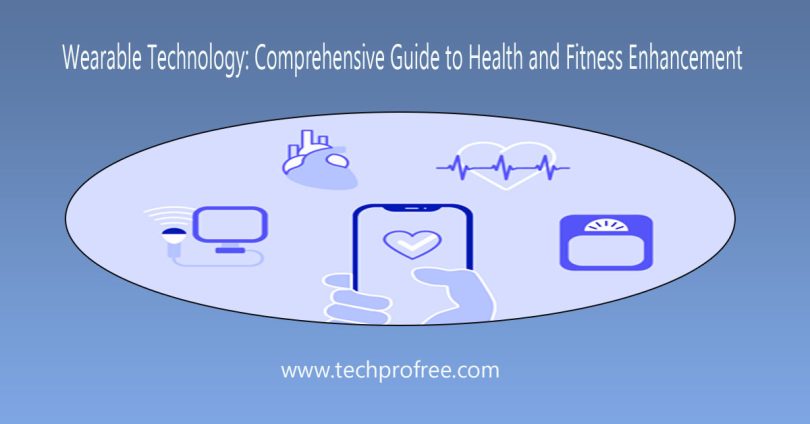Wearable technology has attained significant popularity in current times, appreciation to the surge in smartwatches, fitness trackers and similar wearables designed to monitor diverse aspects of our health and fitness. These tools provide deep looks into our everyday activities, helping us stick to our fitness goals and even enhancing our overall well-being.
We’ll explore how wearable technology is enhancing lifestyle, fitness and health experiences in this post.
Monitoring Health:
Heart rate, blood pressure and sleep habits are just a few of the health data that wearable technology could monitor. The information gathered helps people in the identification of potential health issues and assists in making decisions about their health that are well-informed. A smartwatch that monitors heart rate, for instance, might alert the person who is wearing it if their heart rate is extremely high or low and may cause them to seek medical assistance. Wearable technology that monitors sleep patterns enables people to assess the quantity and quality of their sleep, two factors that are important for general health.
Fitness Monitoring:
Wearable technology has changed the way that fitness objectives are monitored. Fitness trackers record workout sessions in addition to tracking steps and activity levels. Individuals are motivated by this information, which gives them the ability to create goals and achieve desired fitness achievements. For instance, a fitness tracker that counts steps motivates users to exercise more frequently throughout the day, which eventually improves their overall health.
Improving Your Lifestyle:
Additionally, wearable technology has the potential to improve daily life by accelerating and streamlining activities. Such as smartwatches serve as command centers for smart home gadgets, make calls and text messages easier and even support payments through contactless technology. This ease allows people to focus on other duties, increasing productivity as a whole.
Advancements in Wearable Technology:
The field of wearable technology continues to grow with new features and products being launched on a regular basis. Today, some wearables can track menstrual periods, monitor blood oxygen levels or even provide personalized exercise advice. Additionally, wearables are increasingly embracing fashion by providing options for shapes and colors that may be customized depending on individual preferences.
Wearable technology quietly altered the way we go about our daily lives by fusing modern technology into our regular activities. Achievable authenticity has evolved from what was previously only seen in sci-fi films. Our wrists, hands and even our garments are now covered in comfort and useful information.
These clever devices go beyond simple timekeeping and step-counting, enhancing our workout routines and providing a thorough perspective of our health state. They act as our private health and wellness advisors, providing data-based insights to enhance our daily activities.
Exploring Wearable Technology: Choosing Your Wearable Tech Options.
Among multiple wearable options many of these gadgets connect to cellphones and offer a comprehensive overview of activities and health.
But the question still stands that which wearable technology best suits your requirements?
In terms of functionality, smartwatches are similar to smartphones in that they provide call management, messaging, payments, along with step tracking, heart rate monitoring and fitness measurements.
On the other hand, fitness trackers, step counters and heart rate monitors are primarily concerned with health indicators. Consider these factors before making your decision, as some individuals prioritize their well-being over responding to calls or messages.
Purpose: Determine your main requirement. Smartwatches offer a wider range of features if comprehensive fitness monitoring is your goal, but dedicated fitness trackers are your best bet.
Budget: Expensive smartwatches are frequently more expensive. In contrast, there are many different price ranges for fitness trackers.
Battery Life: Similar to smartphones, smartwatches require frequent charging. However, fitness trackers increase battery life.
Combining fashion and utility: Wearables go beyond wristbands. Health-tracking accessories like rings, necklaces and even intelligent footwear and clothes combine beauty with function.
Fitness trackers are useful tools for people who want to keep track of their fitness goals, evaluate the intensity of their workouts and define how they train. In the world of sports, wearable technology that can analyze data like stride rate, ground contact time, stroke rate and force analysis raises the standard of excellence.
Athletes may enhance their performances through this technology. Incorporating these devices into exercise routines enables real-time monitoring, enhancing outcomes and providing more precise data. In order to choose the best fitness tracker for their needs, individuals who are interested in these useful devices need to have a thorough awareness of their operations, workings and potential benefits.
The Purpose/Functions of Fitness Trackers:
The convenience of wearable technology makes it popular, and it may be used to measure physical activity. But what do fitness trackers actually do?
Fitness trackers efficiently capture various health and exercise-related data, depending on their features and models, helping to maintain health. These trackers enable quick and simple activity measurement due to their seamless integration into daily living.
In some models, handling messages and music playback even includes text display, photo and music playback features.
Fitness trackers use a variety of sensors to collect and analyze exercise data, including sensors for altitude, brightness, movement and electric current.
The monitoring functionality of fitness trackers is primarily supported by these sensors…
3-axis Accelerometer: This device measures changes in direction and speed to determine body tilt, preference and orientation. It is essential for recording step counts accurately.
Altimeter: This sensor measures altitude and is useful for activities like mountain climbing. It’s frequently offered in sophisticated variants, requiring an update for traditional trackers.
Optical sensor: This sensor measures fluctuations in blood flow beneath the skin during a pulse and calculates heart rate by using light to track heart rate.
Gyroscope: When used in conjunction with a 3-axis accelerometer, gyroscopes improve the accuracy of three-dimensional workout motions by tracking rotation and orientation.
Temperature sensor: This element monitors body temperature, which reflects increased exertion when body heat rises during exercise.
GPS: The Global Positioning System (GPS) utilizes satellites to determine the location of the fitness tracker accurately.
Beyond the ones listed, there is a wide variety of fitness tracker sensors, many of which are either specialized bracelets or complex software upgrades. The technological system is in alignment with specific requirements for each workout by customizing sensor sets.
Information Tracked via Fitness Devices:
Fitness trackers explore a wide range of health-related data. These trackers, which include a variety of sensors, continuously collect data on a user’s orientation and physical state to help with activity recognition. Fitness trackers may keep an eye on
- Heartbeat
- Sleep habits
- Steps taken
- Calories consumed
- Menstrual cycles
- Calories eaten
- GPS coordinates
A fitness tracker’s features are dependent on the model and price range available. Specialized fitness trackers offer extra features above and beyond what is offered by standard versions because they are designed to meet the specific needs of athletes. Finding an appropriate model provides thorough activity and health monitoring, directing the development of one’s fitness path.
Inside Fitness Trackers: How They Collect and Process Your Information.
A fitness tracker processes an enormous quantity of data inside its variety of sensors and features. The gadget skillfully transforms this sensor-gathered data into information that is simple enough for you to understand.
An explanation of how fitness trackers translate your data is provided here:
Observing Sleep:
Many fitness trackers have a special sleep mode for keeping track of sleep. The device uses an accelerometer and gyroscope to measure movement and determine the state of sleep. The tracker creates a depiction of the sleep cycle by using particular algorithms, heart rate and mobility statistics. This description includes all phases of sleep, from light to deep sleep through awakening, creating a full-encompassing picture of your night’s sleep.
Floor Measurement:
Fitness trackers that have an altimeter and GPS are able to identify elevation changes. The tracker notices these differences as you go up or down and calculates the number of floors that went up using predefined stair height and distance parameters.
Monitoring and Counting Steps:
The most common feature of fitness trackers is step counting. Gyroscope and accelerometer data are processed by the device and steps are calculated by examining movement, distance and speed. The tracker distinguishes between walking, running and motionless moments using a customized algorithm. It provides information on the number of steps completed, speed, calories burned and even pace.
Calculating the Calories Burned:
The calorie information is derived by fitness trackers from initial body composition input. To estimate calorie burn, factors including height, weight, gender, age and heart rate are combined. The complex nature of the various elements impacting calorie expenditure, it means that this estimation will always be approximatively rather than accurate.
The Accuracy and Reliability of Fitness Trackers: Understanding Their Strengths and Limitations.
Fitness trackers’ accuracy depends on elements like models, characteristics of the device and the data available for computation. Depending on the individual, some elements of fitness tracking are more accurate than others. Activity monitoring primarily depends on wrist motion since fitness trackers are typically worn on the wrist. Heart rate and energy expenditure measurements become less precise in activities such as cycling, which involve minimal wrist movement.
Fitness monitors typically have accurate heart rate and step counting. However, calorie prediction and sleep tracking are two areas where precision is insufficient. According to Stanford research, none of the seven fitness bands that were examined could reliably calculate how much energy was expended, with discrepancies ranging from 27% to 93%. The wrist’s constrained location and monitoring technology cause sleep-tracking restrictions.
Although they are not perfect, fitness trackers offer reliable information for estimating exercise levels. They are useful for exercise because of their compact shape and useful wrist location. They are adequate as guidelines for tracking fitness even though their precision is slightly limited.
Benefits/Strengths of Wearable Tech:
Fitness trackers offer significant benefits for anyone motivated to improve their fitness despite their flaws.
- These devices simplify the process of setting fitness goals and tracking success by providing data, workout counts and milestones.
- Additional benefits include text notifications, audio control, waterproofing and sedentary reminders.
- Fitness trackers are motivational tools because they visibly display objectives, progress and current activity levels. With tangible outcomes from beginning to end, this visual demonstration of progress builds momentum throughout the course of time and fosters a feeling of success.
- Fitness trackers are immediate and simple means to start living a better and more active lifestyle that fits in with daily activities.
- Their usefulness is increased by compatibility with smartphones and other devices, providing concrete fitness goals and beneficial workout routines.
- Wearable technology offers a convenient way for people to include fitness in their busy lives.
Drawbacks/Limitations of Wearable Tech:
- Data assessment and analysis need a significant time commitment.
- These devices generate a lot of data, thus processing it can entail a team or committee.
- Strategic planning and monetary considerations are required.
- Obtaining clearance from senior management or the finance team may be necessary prior to full deployment.
- The cost of wearable technology depends on how many people and locations there are in a company.
- Concern about potential focus distraction emerges. Many employees may find it distracting to wear such gadgets for the duration of a shift, especially if they have haptic feedback or vibration warnings.
- The potential for legal, financial and personal penalties makes maintaining data security and privacy of the utmost importance. The IT department should ensure the security of the data produced by the devices, allowing access only to authorized individuals and making sure that each person whose data is being collected has given informed permission.
- The possibility of placing too much or too little dependence on technology becomes apparent. This problem can develop while trying to find real trends in an ocean of data. This condition occasionally causes either unwarranted faith or mistrust in all studied facts before making judgments or putting improvements into place.
Exploring the Future of Wearable Technology: Innovations on the Horizon.
The ascent of wearable technology is evident and broad-reaching, encompassing smartwatches, fitness trackers and VR/AR headsets. They’re sure to grow in popularity and businesses are coming up with inventive new applications for them in daily life.
Following are some fascinating potential prospects for wearable technology.
- Wearables may grow less obvious as they resemble jewelry or covert patches. Some smartwatches are already made to resemble conventional watches. Safety wearables are available that resemble regular jewelry and can alert family members if you are in trouble.
- The batteries in many wearables run out rapidly. The solution being worked on by developers involves using movement, sunlight and body heat to power the devices. This would be highly advantageous as it would eliminate the need for frequent charging concerns.
- Wearables are capable of helping with health, but some can do far more. A diabetic device that monitors blood sugar levels and administers insulin is currently in development.
- In the future, you might have wearables under your skin that monitor a variety of medical data, including blood tests and the effectiveness of treatments.
- Wearables could take the role of tickets and keys. For instance, Disney employs a wristband to allow visitors to its parks. Even smart tattoos are being developed by scientists to perform similar functions. If this becomes popular, it might make it easier to get through security checks and visit the hospital.
In Conclusion: The Evolution and Impact of Wearable Technology on Our Well-Being.
The development of wearable technology has sparked a transformative journey towards better health and fitness in this era of technology that is evolving quickly. We discover a significant shift in the way we interact with our daily routines and sense of well-being as we explore deeper into the complex world of smartwatches, fitness trackers and wearable technologies. These unassuming companions have carefully integrated themselves into the fabric of our existence, keeping a close eye on our health parameters and constantly pushing us to improve our way of living. These unassuming companions are much more than just timekeepers or step counters; they are now our personal health coaches, helping us to understand the complex web of our physiological state.
The integration of wearable technology into our lives has gone beyond the confines of science fiction, blending convenience and utility to such an extent that our wrists, hands, and attire are adorned with both comfort and invaluable insights. With each innovation, they solidify their place as silent architects of our healthier, more informed tomorrows. Picking wearable gadgets, blending fashion with function and syncing technology with our workouts all shape a story where these devices become essential companions in our journey toward better living. As the horizon of wearable technology continues to broaden, ushering in fresh features and products, the seamless blend of innovation and utility promises to steer us toward a future where health, technology and everyday life coalesce in harmony.




Leave a Comment